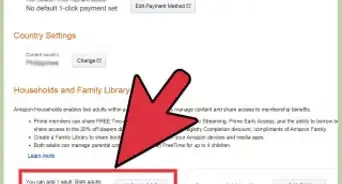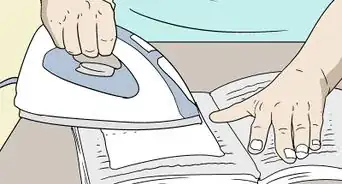This article was co-authored by wikiHow Staff. Our trained team of editors and researchers validate articles for accuracy and comprehensiveness. wikiHow's Content Management Team carefully monitors the work from our editorial staff to ensure that each article is backed by trusted research and meets our high quality standards.
There are 8 references cited in this article, which can be found at the bottom of the page.
wikiHow marks an article as reader-approved once it receives enough positive feedback. In this case, 83% of readers who voted found the article helpful, earning it our reader-approved status.
This article has been viewed 140,647 times.
Learn more...
Book groups are a great way to share a love of good stories with others. Your group can be about any type of literature and can be made up of both friends and strangers. To start a group, you’ll need to find members by advertising your group through word-of-mouth, flyers, or online postings. Set up a time and meeting place that works well for everyone who wants to come. The key to a successful group is to have fun and share in a productive discussion.
Steps
Finding Group Members
-
1Decide on what type of book you’ll read. Your book club can have a specialized focus, such as science fiction novels or poetry. Your group can also stay broad and feature a variety of groups. This is your group, so pick genres you enjoy reading. That way, you’ll be able to find members who share your interests.[1]
- You don’t need to pick any specific books to read right now, but that may help you form a goal about what you want the group to be.
-
2List special traits you want in group members. Most book groups are fairly diverse and stay open to strangers. If you want something different, that’s okay too. You may only want your friends, or you may want to start a women’s group. Think of these before you start forming the group.[2]Advertisement
-
3Invite people you know to your group. The easiest way to start a group is to invite your friends. If you know any friends or family members that would work well in your group, ask them. Make sure they are interested in the kinds of books you want to read.[3]
- A group of all friends can become very chatty, which can take away time from book discussion.
-
4Ask strangers to come to your group. Reach out to people you see around town. People reading books in libraries or coffee shops may be interested in joining your group. You can look at their books and see what they’re interested in. While inviting strangers can seem difficult, they often make book groups better by bringing in new perspectives.
-
5Tell everyone to recommend the group to others. Friends, family, and coworkers may not be right for your group, but they may know someone who is. People who decide to join your group may bring someone they know. Even strangers may have a recommendation for you. Generate group interest by word-of-mouth and you’ll find members you wouldn’t have reached otherwise.
- Say, “If you know anyone who would be interested in the group, let them know about it.”
-
6Post advertisements around town. Print off some flyers from the group. These can be made at home or at a copy shop. Include a brief description of the group’s focus. Tell prospective members what type of book the group will focus on. Include your contact information. Post the flyers around town on community bulletin boards at schools, libraries, coffee shops, community centers, and other busy areas.
- If you have any special conditions for joining, such as gender or age, note that too.
-
7Advertise your group online. Online is a good place for you to connect and keep in touch with anyone interested in your group. Create a group on Facebook or BigTent. Share the group on social media to generate interest. You may also post an advertisement in the community section of Craigslist or similar sites.
Starting the Group
-
1Find a location for your first meeting. Quiet, public places work well for a first meeting. Look into reserving space at a community center, library, church, or cafe. Work with the group members you’ve recruited to find a location. A good location is easy for everyone in the group to reach. Usually you’ll want to meet near where you placed your flyers.[4]
- You can have the meeting in your home, but this may be awkward for people you don’t know well.
- Remember to contact public venues in advance and reserve space for your group.
-
2Work together to come up with a good meeting time. Try to get as many of your group members to show up as possible. Think of a day you’re available and coordinate with your group members and the venue you chose. Everyone has different schedules, so you’ll need to stay open. Usually the weekends are ideal times, since many people are free from work or school.
- The ideal group size is about eight to 16 members. You need enough people to start a discussion, but too many people can make the group too busy.
-
3Invite everyone weeks in advance. People will forget about the meeting, so give them a few reminders. If you can, collect contact information from interested members before you hold the first meeting. Call or email them an invitation two weeks in advance. A day or two before the meeting, send them another quick reminder.[5]
- Your reminder can be a quick message saying, “Looking forward to meeting everyone Saturday!”
Running the First Group
-
1Get acquainted with everyone. You don’t have to discuss a book on the first day. Instead, it’s helpful to spend time getting to know your new group members. Have them introduce themselves and talk about their favorite books. Relax with icebreaker games, such as by placing questions in a hat and having people pick out questions to answer.[6]
- Incorporating some book-based games is helpful. For example, you can have people extend the end of novels or guess who said a quote.[7]
-
2Come up with a group name. Come up with a unique name for your group. A good one makes your group feel official and helps members feel like they belong. Let all the members suggest names.
-
3Plan out when your next meeting will be. Now is a perfect time to get some feedback on the group. Find out when everyone is available. Ask them if the time and location works well for them. Also discuss how often you want to meet. If you need to move the group to a new setting, such as someone’s house, make sure all the other members agree to it.[8]
- As your group goes on, you can keep things fresh by alternating meeting areas. Everyone in the group can take turns hosting at their home, for example. Give people who normally live further away an opportunity to drive less.
- Stick to the schedule during future meetings. When everyone knows what to expect, they can get what they want out of the group.
-
4Set up a reading schedule. If you haven’t picked out a first book yet, discuss this with your group. Come up with a perfect starter book, then figure out how much the members need to read for the next meeting. The right length depends on the book’s difficulty and when you’ll be meeting next. If your group meets a lot, you can limit the reading to a few chapters. Look ahead to make sure these chapters are easy to complete and are compelling enough to discuss.
- Ideas for books can come from group members, bestseller lists, or recommendations from other book clubs.
- Reassure the group members that they’re welcome even when they don’t finish the reading. They can still be part of the group and may still have something to contribute.
- Don’t be afraid to adapt the schedule as you go. Sometimes, you may need more discussion time on a previous reading. Consult your group members to come up with a plan.
-
5Decide who will guide the next meeting. Many groups let the person who suggested the book lead the first discussion. As group leader, you’ll likely do this yourself at first. When you move on to new books, you can try taking turns. Don’t force anyone to lead but do try to spread the responsibility around to other group members.[9]
- The leader should bring in a few questions or discussion topics. Starter questions don’t have to be complex. A simple one is, “So what did you think of the book?”
-
6Establish a discussion schedule. Some groups are more socialization than discussion. Most groups benefit from having both. Remember what you want out of the group and make it known. You can set the tone by working with your group members to set up the schedule. You can limit socialization time to an hour, for example, before following up with book discussion.[10]
-
7Ask about refreshments. Food and drinks make everything better. If you’re meeting at a restaurant or cafe, you probably won’t need to bring anything. You may decide that everyone should bring a dish from home. You may also end up providing a light snack. Figure out what your group should have and who should bring it.[11]
- It can be useful to have everyone bring a dish so one person isn’t stuck preparing all the food. You may also alternate who brings what by creating a schedule.
Conducting a Discussion
-
1Write down notes on the book. As you read the book, jot down the parts that stand out to you. Mark important quotations, character developments, or other details. Include page numbers so everyone can find these parts again. Bring in your notes and use them to have a great group discussion.[12]
-
2Come up with questions. Asking people what they thought of the book is an acceptable starting question. Use your notes to come up with deeper questions or search online for discussion ideas. Write out a list of non-specific book questions in case discussion starts to stall[13]
- Examples of non-specific questions include: "What was the book’s message?" "Who did you identify with?" "How did the characters change?" "Why did the author choose this title?"
-
3Keep things moving when the discussion dies down. As the group leader, it’s your job to keep people engaged. Pay attention to when people seem unenthusiastic or don’t have much to say about a topic. Keeping up the energy level is important to making your group a success. People won’t come back if they feel bored.
- For example, ask the group about the book’s theme. If discussion is slow, say, “I thought what that character did embodied the theme” or “I really liked how the author expressed the theme by saying this.” Explain what the character did or what the author wrote.
-
4Ask group members for questions. Open the floor up to the other members. Is there something about the book they want to ask? Get them involved and have them share their takes on the reading. An interesting discussion can happen because of a question you never thought of.
- Ask them “What did you think of this part?” or “Did anything confuse you about the reading?”
Community Q&A
-
QuestionHow many people make a good book club?
 Community AnswerThe quantity isn't as important as the quality. You wouldn't want to be stuck discussing something you are really into with someone who doesn't care for the topic. You'll want at least enough people to carry on a good discussion, so three or four should probably be the minimum.
Community AnswerThe quantity isn't as important as the quality. You wouldn't want to be stuck discussing something you are really into with someone who doesn't care for the topic. You'll want at least enough people to carry on a good discussion, so three or four should probably be the minimum. -
QuestionIs it okay to create forms for the members before they join the club?
 Community AnswerYes! A form will make it more official and help keep the group organized.
Community AnswerYes! A form will make it more official and help keep the group organized. -
QuestionWould it be good to have membership cards?
 Community AnswerIf you are just starting a book group, membership cards may make the process too complicated. Wait until your book group has been meeting regularly for a year and then ask the members if they want membership cards.
Community AnswerIf you are just starting a book group, membership cards may make the process too complicated. Wait until your book group has been meeting regularly for a year and then ask the members if they want membership cards.
Warnings
- Managing a group can be a lot of work. After the first couple of meetings, let the group run itself. Spread out responsibility so you don’t have to do everything.⧼thumbs_response⧽
References
- ↑ http://www.penguin.com/read/book-clubs/create/
- ↑ http://www.oprah.com/oprahsbookclub/how-to-start-your-own-book-club
- ↑ https://www.litlovers.com/start-a-book-club
- ↑ https://www.realsimple.com/work-life/start-book-club-checklist
- ↑ http://www.oprah.com/oprahsbookclub/how-to-start-your-own-book-club
- ↑ https://www.brit.co/book-club-tips/
- ↑ https://www.litlovers.com/run-a-book-club/games-a-icebreakers
- ↑ https://www.thoughtco.com/how-to-start-a-book-club-362068
- ↑ https://www.gimmesomeoven.com/life/how-to-start-a-book-club/


















































































